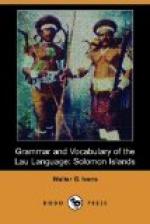In the translations made into Lau, some use has been made of the gerundive, following the use in Sa’a; but until we have further evidence of the validity of this usage it must be regarded as not belonging to the genius of the Lau language, and it is therefore omitted here.
It will be seen that Lau is a typical Melanesian language and has few marked peculiarities. In Sa’a there is a distinctive use of the shortened forms of the pronouns of the first and second persons, au and ’o, suffixed to verbs and prepositions as object; in Lau the same shortening is not effected and the longer forms nau, oe, are used.
It has not been thought proper to represent any break in pronunciation such as occurs in Sa’a in such words, e. g., as ia fish, Sa’a i’e. Lau shows generally the dropping of such consonants as are dropped in Sa’a, but it is doubtful if the same break occurs in pronunciation.
The books already printed in Lau are:
1. A translation of the English Prayer Book comprising matins and evensong, litany, baptism of adults, certain psalms and hymns, catechism, Holy Communion with Sunday collects.
2. The four Gospels.
The grammar here given is an alteration of the grammar prepared by the present writer, and printed at Norfolk Island by the Mission Press in 1914.
W. G. Ivens. St. Paul’s Vicarage, Malvern, Victoria, 1920.
Table of abbreviations.
adj., adjective. adv., adverb. art., article. def.,
definite. demons., demonstrative. excl., exclusive
(of personal pronouns, excluding the person
addressed).
exclam., exclamation. genit., genitive. gu,
marks a noun as taking the suffixed pronouns gu,
mu,
na.
incl., inclusive (of personal pronouns, including
the person
addressed).
interj., interjection. interr., interrogative. metath.,
metathesis. n., noun. na, marks a noun as
taking the suffixed pronoun in the third
singular only.
neg., negative. neut., neuter. obj., object. part.,
particle. partic., participle. pers., person, personal.
pl., plural. poss., possessive. pr., pronoun. pref.,
prefix. prep., preposition. S, Sa’a language.
See Sa’a and Ulawa dictionary. sing., singular.
sub., subject. suff., suffix, suffixed. term., termination.
tr., transitive. U, Ulawa language. See
Sa’a and Ulawa dictionary. v., verb. v.i.,
verb intransitive, i.e., a verb which can not
take the
pronoun suffixed.
v.p., verbal particle. v.tr., verb transitive, i.e.,
a verb which can take the pronoun
suffixed.
voc., vocative. M.L., Codrington’s Melanesian
Languages.




